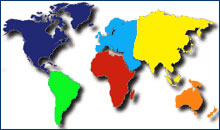Photography & Videography on the road
A great picture is worth a thousand travel miles
Before you start packing your $700 Nikon and assorted lenses, buying extra memory chips for your digital camera, or even going old-school and stuffing rolls of Fuji into a lead bag, you need to come to terms with one thing.
Someone with an array of equipment far more sophisticated than yours, with a tripod, who could afford to wait 365 days for the best light and waste 36 exposures to get everything just right has taken a much better full-frame picture of that monument, church, or painting than you could ever hope to get.
It’s called a postcard. Accept this and buy a shot of St. Peter's or the David that was made by a professional.
Of course you’ll take a picture of it anyway, and Im not going to stop you. Just don’t waste more than one shot on an overall view. Instead, make your photos interesting, make them unique, and take home chips full of travel memories and great pictures, not just snapshots. The next page contains tips for doing just that. But before the shooting tips, a few general pointers.
What kind of camera to bring
Unless you’re a professional or a real heavy-duty amateur, the fanciest camera you need is a basic Digital SLR (Single Lens Reflex) and the kit lens it comes with (though do look for deals that include two lenses, one wide-angle—say an 18–55mm—and a second lens for telephoto—perhaps 55–200mm). Get a lens cap with a little string to dangle it from the lens so you don’t lose it.
This should cost you no more than $700—unless you want it to. Sure, you could easily spend $5,000 on a good digital camera, but the "prosumer" models—Nikon D7000, Sony alpha series, Cannon EOS Rebels—all clock in at $490 to $1,200 (largely depending on the kind of lens you spring for).
Of course, you can also get by perfectly well with a pocket point-and-shoot digital camera. These days you can get quality digital cameras that shoot 10 megapixels, remain waterproof up to 10 feet underwater, and come with all the bell-and-whistle features for well under $300.
Should you stick with film, even basic point-and-shoots are getting more advanced every day. Some even let you switch film halfway through rolls (great for moving from outdoor shots that call for 100 ASA to dark cathedral interiors that want at least 400 ASA).
Invest in at least a low-end pocket camera; don’t bother with a disposable camera, which take, at best, passable pictures and even then only under full, bright sunlight. The only useful disposable cameras are, if you think you’ll need one, the ones that work underwater.
Before you leave home: Know thy camera
Practice with your camera before you leave the States, especially if it’s a new one and you’re not sure how it behaves. Visit the sights of your home city, pretend you’re in Italy, and snap away. Get to know the camera. Bracket your shots by shooting the same thing several times using different settings, with and without flash, and so on. Write down carefully exactly what you did or varied in each shot so that, later, you'll know which ones worked best.
Sure, you’ll waste half a day doing all this, but it’s better to know how the camera handles with different films and in different situations before you go off and miss that perfect shot on vacation.
Don’t leave home without them: Buying film & memory chips
Buy all the memory chips you'll need for your digital camera (and, for that matter, your film) in the United States. It’s cheaper, and you can be sure it hasn’t been sitting on the shelf since 1982.
If you're taking chips, I'd suggest bringing a bare minimum of 1 gig (gigabyte) of memory for every two days on of your trip. Myself, I routinely shoot about a gig a day (more if a festival breaks out), so I travel with enough chips to total about 2 gigs per day to be safe.
tip
Make your chips last longer by performing imagery triage as you go, deleting extraneous images each evening—those too blurry, underexposed, or poorly framed to be worth keeping—so as to free up more room on the chip for the next day. I tend to do this at dinner table after I've ordered (and taken my notes on the restaurant) and am awaiting my food.
I prefer carrying a handful of 2G, 4G and 8GB chips and swapping them out as they get full rather than taking, say, a single 32G chip. This is just for insurance purposes. If that one mega-chip gets corrupted, lost, stolen, or dropped in the toilet, at least you haven't lost an entire vacation's-worth of photos.
If you'll still into film, buy enough to shoot at least one roll a day, more if you know you’re the shutter-happy type. Bring more than you think you’ll need. You can always use the extras after you get home, and it might save the day if you run into a festival and find yourself going through a roll an hour.
Hold on to the plastic film canisters and store them in big, see-through plastic baggies so security people at the airport will pass it around the potentially harmful X rays (the higher the film speed, the more likely multiple exposures to X rays will fog the film).
Bring several spare batteries (if you're using rechargables, you must pack these in your carry-on bag due to new TSA rules as of 2008).
Use a UV filter on the lens to protect it from scratches (not a polarizing filter, which messes up more shots than it helps if you don’t use it correctly).
If you do have to buy photo supplies, film, or memory chips abroad, go to a camera shop or department store. Never buy film from a souvenir stand near a tourist sight. The markup is almost criminal.
Related Articles |
Outside Resources |
This article was last updated in August 2007. All information was accurate at the time.
Copyright © 1998–2010 by Reid Bramblett. Author: Reid Bramblett.



 ShareThis
ShareThis

